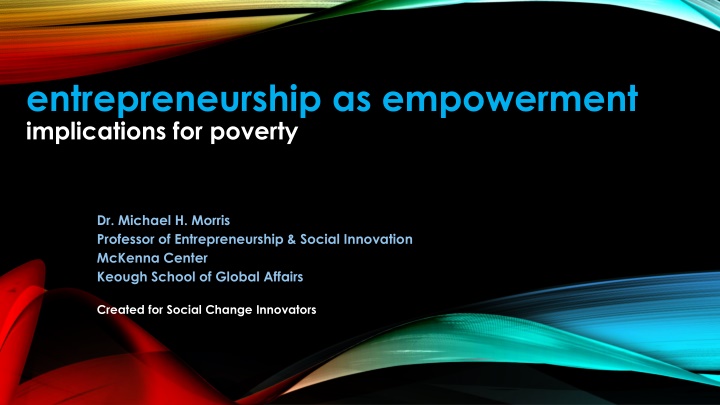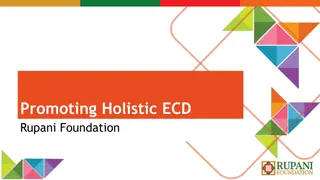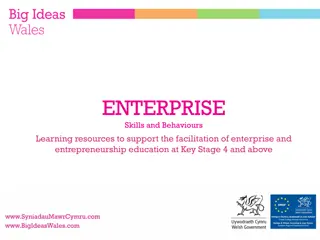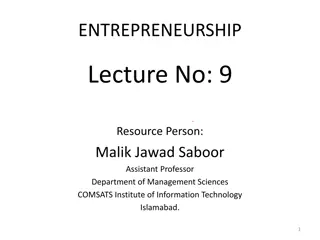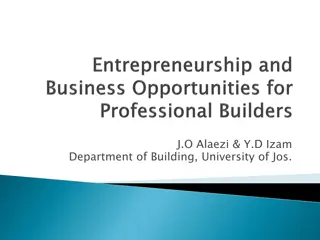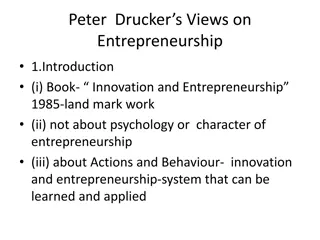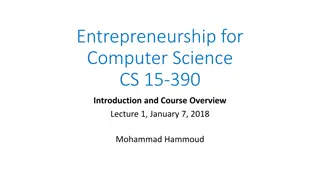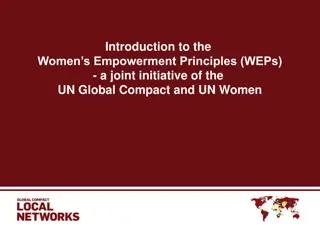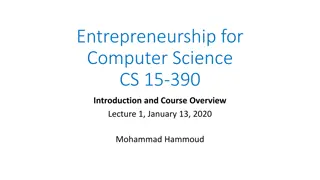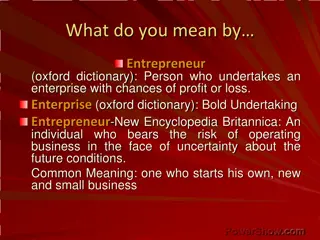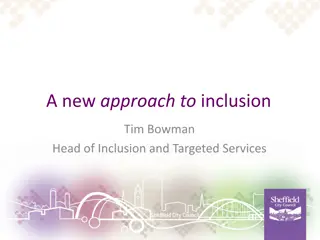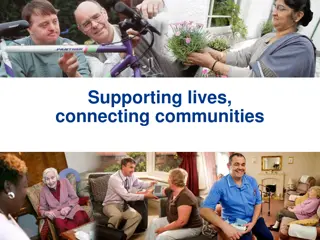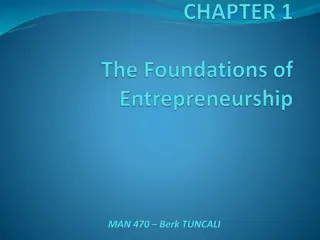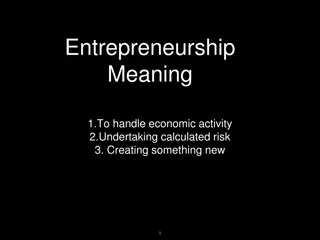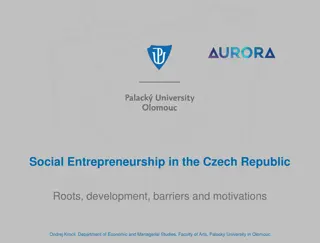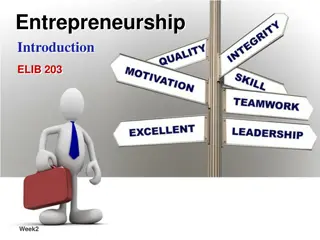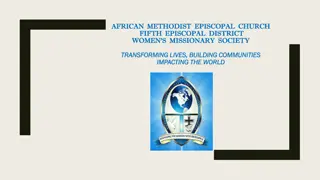Entrepreneurship as Empowerment: Transforming Lives and Communities
Entrepreneurship, as defined by Dr. Michael H. Morris, is the recognition and pursuit of opportunities, creating value through unique resource combinations. Empowerment through entrepreneurship enables individuals to create their own jobs, identities, futures, and contribute to the world, leading to transformation in markets, industries, and economies. Despite global poverty challenges, entrepreneurship serves as a powerful tool for poverty alleviation and societal change, with implications for both developing and developed economies.
Download Presentation

Please find below an Image/Link to download the presentation.
The content on the website is provided AS IS for your information and personal use only. It may not be sold, licensed, or shared on other websites without obtaining consent from the author.If you encounter any issues during the download, it is possible that the publisher has removed the file from their server.
You are allowed to download the files provided on this website for personal or commercial use, subject to the condition that they are used lawfully. All files are the property of their respective owners.
The content on the website is provided AS IS for your information and personal use only. It may not be sold, licensed, or shared on other websites without obtaining consent from the author.
E N D
Presentation Transcript
entrepreneurship as empowerment implications for poverty Dr. Michael H. Morris Professor of Entrepreneurship & Social Innovation McKenna Center Keough School of Global Affairs Created for Social Change Innovators
what is entrepreneurship? the creation of a venture recognizing and capitalizing on opportunity pursuit of opportunity regardless of resources controlled the process of creating value through unique resource combinations to exploit opportunity
empowerment transformation
empowerment to create your own job to create your own identity to create your own future to create your own wealth to create your own sense of pride and self-worth to create your own facilities and operations to create jobs for others to create your own contribution to the world to create your own ability to give back
transformation transforming markets transforming business practices transforming industries transforming oneself transforming families transforming communities transforming economies
the global reality 22 percent of the world s population live in poverty (less than $3.20 a day) 10 percent of the world s population (734 million people) live in extreme poverty (less than $1.90 a day) for every 1,000 children born, 39 will die before they turn five years old one-third of the urban population across the globe lives in a slum due to COVID, poverty rates will go up globally for the first time since 1998 much of the progress from the past ten years stands to be undone
and in developed economies? U.S. standard: a family of four earning less the $24,600 top quintile of households account for 51.1 percent of income, bottom two quintiles account for 11.3 percent one of every seven people in U.S., or 44 million people, live in poverty --- many more experience low income in absolute terms. just under half of them are in deep poverty, defined as living on half or less of the official poverty income level. almost 13% of U.S. households will experience hunger and food insecurity at some point during a given year. the gap is getting bigger
failure to alleviate the problem governments around the world spend trillions of dollars each year on poverty alleviation program spending per person continues to rise. yet the poverty rate remains unacceptably high and while poverty in developing economies is slowly going down, it is largely unchanged in developed economies (about 14% for over 50 years in U.S.) and the gap between the haves and have nots continues to grow
what about entrepreneurship? a different solution to poverty
not just an inability to afford necessities - tend to be less educated with access to lower quality educational resources - experience more crime - have higher teen birth rates - endure more serious health challenges - have more difficult finding and getting jobs - frequently come from single-parent households - tend to suffer more in economic downturns - have a shorter-term orientation - must deal with more discrimination - are less socially integrated into society - and have personal networks that offer them with less access to opportunity
implications these characteristics of poverty affect -opportunities the poor are able to identify -nature of the ventures they start -time entrepreneurs have to spend on the venture -ability of entrepreneur to access ecosystems -ability of entrepreneur to plan think strategically -nature of market entrepreneur is able to penetrate -resource entrepreneurs are able to employ -returns entrepreneurs are able to generate
the evidence there is evidence that the poor start a considerable number of formal sector ventures, and an even greater number of unregistered businesses (Amor s & Cristi, 2011; Banerjee & Duflo, 2011) using data from Kauffman Foundation, Slivinski (2015) calculated an average low-income entrepreneurship rate in the USA of 0.38%, notably higher than the national average of 0.30% minorities are more heavily represented among the poor and they have demonstrated higher start-up rates in recent decades compared to society at large (Barr, 2008; Edelman, et al., 2010). Panel Study of Entrepreneurial Dynamics data indicate that, while the poor represent 14% of the US. population, about 17% of nascent entrepreneurs live in low-income households (Edmiston, 2008).
the evidence Slivinski (2015) over 7-year period found that those states with highest rates of entrepreneurship demonstrated the largest reductions in poverty, while lower rates of entrepreneurship corresponded to increases in poverty. For every percentage point increase in the rate of entrepreneurship there was a 2% decline in the poverty rate. Aspen Institute followed 405 individuals running microbusinesses for 5 years, of which 133 were in severe poverty. They found 72% of the poor entrepreneurs increased their household income over 5 years, with an average increase of $8,484 enough to move 53% of them out of poverty. Further, entrepreneurs in poverty were able to reduce their dependence on public assistance programs by 61%.
the importance of these ventures some suggest ventures launched by people in poverty are unproductive or inefficient uses of societal resources, should not be supported, (Shane, 2009). these ventures serve market niches not addressed by high growth start-ups or larger, incumbent firms. They enhance competition, pay taxes, stabilize neighborhoods, and are often immersed in the fabric of the community. they provide a developmental experience for the entrepreneur, enhancing his or her knowledge base, skills, and self-efficacy. And in spite of lean resources, many are able to survive and thrive for many years. they are inter-dependent with other types of start-ups and constitute an important component within an overall portfolio of new ventures (Morris et al., 2015).
its not about the next Morris, M and Kuratko, D. (2020) What do Entrepreneurs Create?, Northhampton, MA: Edward Elgar Publishing.
SPODER Model supportive infrastructure (S) preparation of the entrepreneur (P) resource leveraging (R) enhanced economic model (E) expanding opportunity horizons (O) differentiation (D) Morris, Santos, Neumeyer, N (2018), Entrepreneurship and Poverty in Developed Economies, Northhampton, MA: Edward Elgar Publishing.
south bend (and other cities) entrepreneurship and adversity program
training research consulting SBEAP mentoring funding community connections
leveraging campus & community resources campus law school, campus procurement, computer science, college of education, college of engineering, arts and sciences, architecture, public health, construction management, the arts, social work, women s studies, etc. community city government, city procurement, Goodwill, housing authority, local community colleges, economic development groups, black leaders, Hispanic and Latino chamber of commerice, local nonprofits, local sbdc, neighborhood associations, women s leadership groups, etc.
how it works 12 month program (start in august or january) bootstrap it the first year and money will come 2-3 months for marketing (top down and bottom up) target enrollment of 50 (67 in first South Bend cohort) first phase is six saturdays of training (then once a month) a month before training begins we start building the mentoring pool if you finish training, then you get a mentor (successful entrepreneur) for at least six months quarterly community connect events (leads to resource pool) then student consulting starts in second semester of program tracking/research is happening throughout (25 metrics and over three years) takes longer (wo years or so) to get the microcredit piece in place
types of ventures property preservation cleaning service wearable technology bakery and other food items restaurant, food truck, catering online boutique transport (of people or goods) lifecoaching baby bibs and tutus fusion of art and therapy companionship with adults or special need kids deejay services body care products clothing jewelry mobile spa business pop shop - snack store personal training handyman services commercial hvac systems underage party bus used auto dealership multimedia news website powder coating Candles fertilizing and pesticide services
Low margins High Unit Costs Intensely competitive Labor intensive Low prices Commodity Trap No No bargaining power differentiation Limited capacity / Low volumes No technology
need a different toolkit not the lean start up not in the idea killing business expanding the opportunity horizon the five literacies escaping the commodity trap profit model extreme leveraging, bootstrapping and guerrilla skills changing the ecosystem 100 step journey --- for each one we help with, you take three more
developing what the person as an entrepreneur and manager (and the mindset is even more important than business skills) the business
entrepreneurship as a mindset Attitude - i can affect change - there is a better way - opportunities are everywhere - embrace innovation, change & growth - failure is learning - optimism - passion for what you do Professionally Behavior In One s Life - pursuing opportunity - innovating - perseverance - leveraging - guerrilla actions - risk management - adaptation
global partnership for poverty and entrepreneurship (GPPE) website portal best practices community engagement initiatives teaching initiatives research initiatives scholarly and applied inventory of tools and frameworks collaborations and sharing opportunities jointly pursuing grants GPPE website: https://gppe.nd.edu/ ; contact mmorri24@nd.edu
